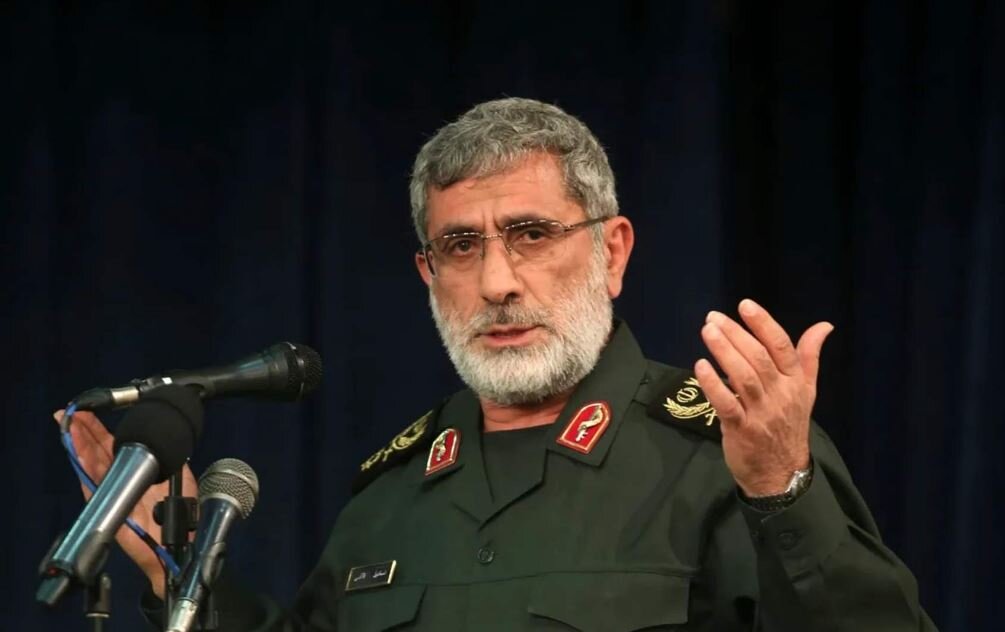Esmail Qaani: target of a Zionist disinformation campaign amid rising regional tensions

MADRID – In recent days, various Western and regional media outlets have raised questions regarding the whereabouts of Ismail Qaani, the head of the Iranian Revolution Guard Corps (IRGC) Quds Force.
Recently, the news agency Reuters, known for its history of false reporting concerning Iran, published an article claiming that after the Israeli attacks in Beirut, which resulted in the deaths of Hassan Nasrallah and Iranian General Abbas Nilforoushan, “contact with Ismail Qaani has been lost.”
Meanwhile, the Qatari-funded outlet Middle East Eye provided a more elaborate version in an article labeled as an "exclusive," published on October 10 on its website. It claimed that the commander of the Revolutionary Guard is under house arrest and is being interrogated by the Islamic Republic's intelligence forces. However, Iranian experts pointed out that Middle East Eye failed to provide explanations for the alleged reasons behind this arrest and interrogation.
In the following days, after Iranian sources refuted Middle East Eye's article, the outlet turned to anonymous sources in Iraq and Lebanon to reiterate its unfounded claims. Iran International, a Persian-language outlet linked to the Zionist regime and covertly directed by Manouchehr Amir, a former director of Radio Israel, cited an "informed source" claiming that Commander Qaani's family also had no news regarding his whereabouts or what he was doing.
Additionally, Sky News published a supposed detailed report stating that Qaani had suffered a heart attack during an interrogation and was receiving treatment. According to this version, "close sources" to Sky News were unaware of the commander’s current condition following the incident.
Finally, the Saudi channel Al Arabiya questioned, “Why is there no news about Commander Qaani? He was absent from the command room during Operation 'Sacred Promise 2,' from the Friday prayer in Tehran led by the Supreme Leader, and from the ceremony awarding the Victory Medal to Commander Hajizadeh. Where is Commander Qaani?”
From the Islamic Republic, various explanations have been provided regarding the state of the Quds Force commander. On October 7, a high-ranking official from the Islamic Revolutionary Guard Corps confirmed that General Qaani was in good health. Moreover, the same official indicated that Qaani had issued a message to commemorate the anniversary of the Al-Aqsa Flood Operation. In line with this, the deputy coordinator of the Quds Force stated, “Many of us ask, 'What happened to Commander Qaani?' He is healthy and active. Some say, 'Make a statement!' Why make a statement? There is no need for that.”
Just a few days ago, the Iranian parliamentary president, Mohammad-Bagher Ghalibaf, during an official visit to Beirut, stated that "Qaani is in good health, continues to fulfill his duties, and the rumors that have been spread about him are false and malicious."
Finally, putting all rumors to rest and debunking the fake news, Qaani personally appeared at the funeral procession of IRGC commander Abbas Nilforooshan on October 15th. The media outlets that spread these unverified rumors and misinformation have not apologized. Their objective was simple: to spread disinformation.
According to many international relations experts, such as Iranian analyst Afifeh Abedi, the disinformation surrounding Ismail Qaani’s whereabouts and health was part of a clearly orchestrated strategy by Israel, with three main objectives:
1. Instilling insecurity: to generate and increase a sense of insecurity within Iranian society, especially in the context of possible attacks. This strategy aims to destabilize the internal environment and instill fear among the population.
2. Gathering intelligence for Assassination: to collect information on the Quds Force commander to facilitate a potential assassination. By obtaining relevant data about his location and activities, conditions can be created for an attack.
3. Discrediting Qaani and fostering internal divisions: to undermine the image of Commander Qaani and encourage internal divisions in Iran. Through disinformation and negative propaganda, the goal is to weaken his standing and sow discord among different factions within the country.
The long-standing tradition of narrative control and information manipulation by Zionist entities is well-known. The Israelis refer to this strategy as "hasbara," which means "explanation" in Hebrew. Hasbara encompasses efforts to promote a narrative that justifies Israel's policies and actions. This involves shaping public perception, influencing media coverage, and disseminating information that supports Israeli interests while countering opposing viewpoints.
The weaponization of antisemitism serves as a cynical example of how hasbara strategies are implemented, designed solely to divert criticism and shift the conversation. Discrediting reputable critics and objective critiques of the State of Israel as a colonial entity, through the spread of irresponsible allegations of hatred towards Jews, which Zionist apologists know to be false, reflects the hasbara mentality. This approach not only seeks to silence dissenting voices but also manipulates public perception regarding the Israeli-Palestinian conflict and Israel's policies.
In the current conflict between the Zionist colonial state and the various members of what is known as the Axis of Resistance, the use of hasbara is characterized by three key elements:
1. Unscrupulous tactics: Tactics aimed at discrediting opinions perceived as hostile, which include lies, defamation, and subsidized campaigns.
2. Increased sophistication: A more sophisticated strategy that involves diverting criticism through false allegations.
3. Abundant funding: Both public and private funding of pro-Zionist messaging, aimed at garnering support and dismantling adversaries. This influx of resources allows hasbara to operate more effectively, amplifying its impact and reach within public opinion.
A notable aspect of this extensive psychological warfare is the surprising division of labor and coordination among Israeli media, Western outlets, and anti-Iranian Arab media in shaping narratives, often citing anonymous sources. This information ultimately spreads through opposition media, particularly anti-Iranian outlets like Iran International.
The ultimate objective of this massive disinformation campaign, as noted by Abedi, was to disrupt the operational activities of Qaani, uncover the location and activities of this commander on the battlefield, and ultimately prepare the ground for his assassination.
Leave a Comment